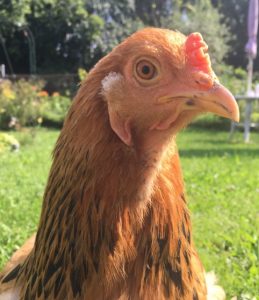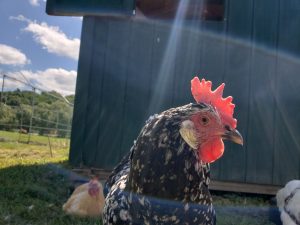Most of us know about the cruelty of factory farming in the egg industry — Chickens are crammed into small wire cages where they are unable to move around, their beaks are cut without anesthesia so they don’t peck at each other from being stressed, they’re sent to slaughter after a year when their egg production decreases and male chicks are killed within 24 hours of being born by being tossed in a giant macerator or suffocated in trash bags alive. What many don’t hear or talk about are the small scale backyard chicken flocks.
The humane myth has said that it is okay to eat chickens eggs when you know where they are coming from, when you know they are being treated well at a local farm or from your neighbor who has chickens free ranging in their backyard – they’re not living in cages and they are happy.
 Oliver is a bantam (small breed) chicken who was found abandoned at an old farm. Roosters (male chickens) are the most neglected and dumped animal in the world because they don’t lay eggs and most towns prohibit them because they crow and are considered a “nuisance”. Two-three times a year animal feed stores and pet stores sell baby chicks and often advertise them as “pullets” which are young hens for us to exploit for eggs. These chicks came from the same hatcheries as the chickens in industrial farms who use the same horrific practices for the males who are born. It is very difficult to tell the difference between the males and females when they are really young and many males mistakenly get sorted into the female pile and escape the fate of being ground up alive. When we buy baby chickens there is a 50/50 chance they are a rooster and 5-6 months later they start to crow. Once they crow, out they go. Rescues and sanctuaries are over capacity from unwanted roosters and often have to turn down the overwhelming amount of requests due to not having space for them. For every hen you see there is a rooster abandoned or dead somewhere.
Oliver is a bantam (small breed) chicken who was found abandoned at an old farm. Roosters (male chickens) are the most neglected and dumped animal in the world because they don’t lay eggs and most towns prohibit them because they crow and are considered a “nuisance”. Two-three times a year animal feed stores and pet stores sell baby chicks and often advertise them as “pullets” which are young hens for us to exploit for eggs. These chicks came from the same hatcheries as the chickens in industrial farms who use the same horrific practices for the males who are born. It is very difficult to tell the difference between the males and females when they are really young and many males mistakenly get sorted into the female pile and escape the fate of being ground up alive. When we buy baby chickens there is a 50/50 chance they are a rooster and 5-6 months later they start to crow. Once they crow, out they go. Rescues and sanctuaries are over capacity from unwanted roosters and often have to turn down the overwhelming amount of requests due to not having space for them. For every hen you see there is a rooster abandoned or dead somewhere.
Roosters experience temporary hormonal behavior that only lasts through their first and second spring. This is when you will hear backyard chicken keepers say that their roosters have become aggressive. This is usually the time when they start to become territorial and protective of their flock. Because their spring hormones are misunderstood as “aggression,” backyard chicken keepers will kill them, offer them for free on craigslist or lock them outside of the coop at night for predators to get them.
Chickens today have been selectively bred to lay more eggs than their jungle fowl ancestors, laying over 300 eggs per year versus 12 eggs a year their ancestors had laid for reproduction. This includes chickens purchased for backyard eggs. Just as Leghorn and Red Star hens exploited in industrial farms, backyard chickens experience the same life threatening health risks caused by their bodies being forced to produce more eggs than they naturally would such as uterine and ovarian cancer, prolapse (caused by the continuous pressure and fatigue in the reproductive organs from pushing out egg after egg which causes their uterus and other reproductive organs to fall out of their body), and egg yolk peritonitis, a common infection caused by the ovaries producing more egg yolk than what their body can keep up with and unshelled egg yolk collects in their abdomen, becomes a bacterial incubator inside their bodies.
 Asa, a backyard chicken rescue from a neglect situation, laid approximately 3-4 eggs per week. Because she had a hyperactive reproductive system, her reproductive organs became enlarged and inflamed. At only 12 months old she needed to have a surgical procedure to remove three eggs that were impacted inside of her. Chickens hide illness very well. Many caretakers don’t even recognize the signs that their chickens are ill and most won’t take their chickens to the vet at all if they are showing any signs of needing immediate vet care. If Asa hadn’t been rescued she wouldn’t have gotten the care that she needed. Hen’s bodies start to become fatigued from the constant laying. If eggs haven’t take their life yet, their laying starts to decrease between the ages 1.5 to 4 years old. Just like industrial farmed hens, they are considered useless during this time and are either dumped outside, killed by decapitation in their own backyard, or sent to an inexpensive slaughterhouse.
Asa, a backyard chicken rescue from a neglect situation, laid approximately 3-4 eggs per week. Because she had a hyperactive reproductive system, her reproductive organs became enlarged and inflamed. At only 12 months old she needed to have a surgical procedure to remove three eggs that were impacted inside of her. Chickens hide illness very well. Many caretakers don’t even recognize the signs that their chickens are ill and most won’t take their chickens to the vet at all if they are showing any signs of needing immediate vet care. If Asa hadn’t been rescued she wouldn’t have gotten the care that she needed. Hen’s bodies start to become fatigued from the constant laying. If eggs haven’t take their life yet, their laying starts to decrease between the ages 1.5 to 4 years old. Just like industrial farmed hens, they are considered useless during this time and are either dumped outside, killed by decapitation in their own backyard, or sent to an inexpensive slaughterhouse.
 Eggs are made up mostly of calcium and other vital nutrients When hens lay eggs, they lose that calcium and other vital nutrients from their bodies. Their jungle fowl ancestors who laid 12 eggs a year were able to replenish those nutrients on their own. Because hens today lay one, sometimes two, eggs a day, they physically can’t replenish the lost nutrients, which can lead to osteoporosis and bone fractures. To help replenish not all, but some of the lost vitamins, eggs should be fed back to hens. Aloki was welcomed at Catskill Animal Sanctuary in 2016 when her owner threatened to kill her because she was eating her own eggs. She lived happily at her new sanctuary home, was fed back her eggs daily and experienced love for the first time. She passed away from reproductive prolapse.
Eggs are made up mostly of calcium and other vital nutrients When hens lay eggs, they lose that calcium and other vital nutrients from their bodies. Their jungle fowl ancestors who laid 12 eggs a year were able to replenish those nutrients on their own. Because hens today lay one, sometimes two, eggs a day, they physically can’t replenish the lost nutrients, which can lead to osteoporosis and bone fractures. To help replenish not all, but some of the lost vitamins, eggs should be fed back to hens. Aloki was welcomed at Catskill Animal Sanctuary in 2016 when her owner threatened to kill her because she was eating her own eggs. She lived happily at her new sanctuary home, was fed back her eggs daily and experienced love for the first time. She passed away from reproductive prolapse.
Due to selective breeding, hens can’t escape from what the egg industry has done to their bodies. Even after finding sanctuary, they suffer every single day and ultimately lose their life from producing so many eggs. Eggs hurt, whether it be in industrial farms or backyard flocks. There is no such thing as humane eggs.
